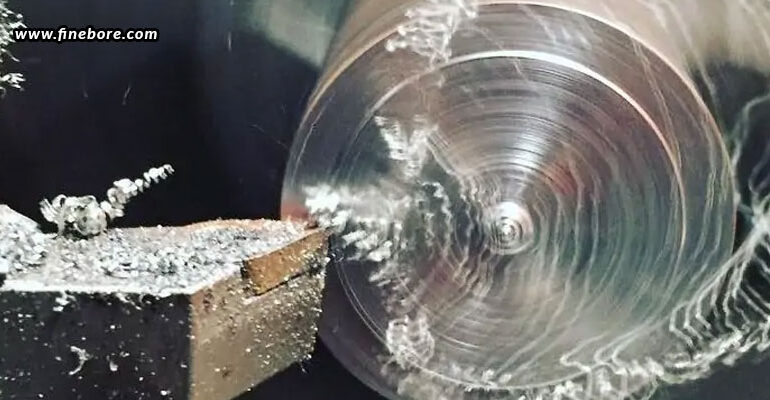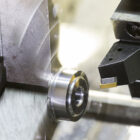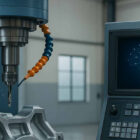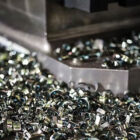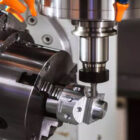Boring bars enable machinists to enlarge holes and attain tight tolerances, making them indispensable equipment in precision machining. Even seasoned machinists, nevertheless, are susceptible to errors that reduce precision, result in subpar surface finishes, or raise scrap rates. It is essential to comprehend and steer clear of common errors pertaining to tool setup, selection, and machining procedures in order to guarantee success in boring operations. This blog will highlight the most common errors encountered when using boring bars and offer fixes to increase precision, extend tool life, and cut down on waste.
Mistake – Improper tool selection
One of the most common problems machinists make when utilizing boring bars is poor tool selection. The diameter of the hole, the depth of the bore, and the material to be machined must all be taken into consideration while selecting a boring bar. Incorrect tolerances, excessive tool chatter, and subpar surface finishes can all result from improper tool selection. Choosing a material such as high-speed steel when carbide would provide better wear resistance, or using a boring bar with the incorrect nose radius for the desired surface finish are common mistakes that result in excessive tool deflection.
Solution – Machinists must make sure they select a boring bar with the right length-to-diameter ratio in order to prevent these issues. A shorter boring bar will decrease deflection and increase rigidity for deeper bores. The boring bar’s material should be appropriate for the workpiece; high-speed steel is more economical for softer materials, but carbide boring bars are best for situations requiring longer tool life or harder materials. It’s also necessary to modify the nose radius according to the application; whereas greater nose radii can enhance surface smoothness, they may also lessen tool stiffness. It’s crucial to strike a balance between these two aspects in order to get tight tolerances and fine finishes.
Mistake – Incorrect setup and alignment
If the boring bar is not properly positioned and set up, it can perform worse than the best ones. Inaccuracies, excessive tool wear, and subpar surface finishes are frequently caused by improper tool setup. One of the most common problems is uneven results caused by the boring bar not being aligned correctly with the hole’s centreline. Other typical errors include utilizing an excessive tool extension, which makes the boring bar excessively flexible and vibration-prone, misaligning the boring bar with the spindle, which results in uneven material removal and tool deflection, and poor toolholder or boring head configuration, which generates chatter.
Solution – Machinists should make sure the boring bar is properly aligned with the spindle centreline in order to address these problems, as misalignment can lead to poor dimensional accuracy and rapid tool wear. To preserve stiffness and prevent chatter, the boring head must be set up correctly, making sure the toolholder grips the boring bar firmly. Furthermore, preserving stability requires minimizing tool extension; boring bars shouldn’t be extended past their necessary length from the holder. Accuracy and surface finish for deep bores can be enhanced by employing dampened boring bars or tools made to lessen vibration in long-reach applications.
Mistake – Incorrect toolholder or machine setup
The performance of a boring bar can be significantly affected by how it is mounted in the machine. Using an inappropriate or subpar toolholder is one typical error that causes poor rigidity and increased tool deflection. Furthermore, excessive movement during machining might be brought on by incorrectly tightening the boring bar in the toolholder, which will decrease precision. In addition, a lot of machinists ignore issues with the machine itself, including misaligned axes or worn spindle bearings, which can cause chatter and vibration.
Solution – It’s crucial to utilize a high-quality toolholder that works with the boring bar and the machine in order to prevent these problems. The toolholder must have superior rigidity and grip in order to avoid deflection. During machining, make sure the boring bar is firmly fixed in the toolholder and does not move. To preserve machining precision and stability, it is important to execute routine maintenance on the machine. This includes making sure the axes and spindle are properly aligned and that any worn-out parts are replaced or repaired.
Mistake – Improper cutting parameters
Incorrectly setting cutting parameters, like depth of cut, feed rate, and cutting speed, is a frequent error that can have a detrimental effect on surface finish and accuracy in boring operations. A lot of machinists utilize general parameters or neglect to modify them according to particular materials and machining circumstances. Frequently made errors include setting the cutting speed of the machine too high or too low, which can lead to overheating or excessive tool wear. Furthermore, a common problem is utilizing an incorrect feed rate—too fast, which results in noise and poor surface finishes, or too slow, which causes built-up edge on the tool. Cutting too deeply can also cause chatter and deflection, which can affect the outcome.
Solution – Machinists should adhere to the suggested cutting speeds for the particular material and tool being used in order to prevent these mistakes. Softer materials can tolerate quicker cutting rates, but harder materials need slower speeds to avoid excessive tool wear. Depending on the desired finish and tool strength, the feed rate needs to be changed. While roughing can be done at quicker feed rates, finishing passes benefit from a slower feed rate for better surface quality. Furthermore, machinists should increase the depth of cut during roughing, within the tool and machine’s limits, to effectively remove material, while maintaining a shallow cut depth during finishing to preserve accuracy and prevent tool deflection. Hence, all the cutting conditions should be comprehended for maximizing boring bar performance.
Mistake – Neglecting cutting fluid or using the wrong type
Cutting fluids are essential for boring operations because they remove chips, lubricate, and provide cooling. However, a lot of machinists forget to utilize cutting fluids or use the wrong type of fluid, which can result in poor surface finishes, overuse of tools, and workpiece thermal deformation. Some common errors include applying cutting fluid inefficiently, which leads to insufficient cooling and lubrication, choosing the incorrect type of fluid (e.g., using an oil-based lubricant when a water-based coolant would provide a better surface finish), and not using any cutting fluid at all, which increases heat buildup and tool wear.
Solution – It is important to always utilize cutting fluid during boring operations to prevent these problems, especially in deep bores where heat accumulation might be an issue. The material and cutting conditions must be taken into consideration when choosing a cutting fluid type. For instance, water-based coolants are better at dissipating heat than oil-based lubricants when it comes to attaining a fine surface finish in harder-to-machine materials. Furthermore, make sure the cutting fluid is delivered correctly. To give the cutting zone with enough cooling and lubrication, use mist or flood coolant applications.
Mistake – Poor chip evacuation
Since chips tend to build in the hole, efficient chip evacuation is essential in boring operations. Inadequate control over chips can result in issues such as chip recutting, surface damage, and even tool breakage. Frequent errors include utilizing a cutting tool or boring bar with the wrong rake angle, which makes effective chip evacuation difficult, and neglecting to clear chips on a regular basis, which results in surface scratches and tool damage. Additionally, permitting chip building in deep bores causes tool deflection and chatter.
Solution – Positive rake angle tools encourage smoother chip flow and lessen chip packing, especially in softer materials, so machinists can avoid these problems. During machining, high-pressure coolant or air blasts can be used to remove chips from the hole efficiently. Peck boring, in which the tool is periodically retracted to remove chips, helps reduce the danger of surface damage and tool wear for deeper holes, resulting in smoother operations and better outcomes.
Mistake – Ignoring tool wear and maintenance
One frequent error that can result in inaccurate results, greater scrap rates, and subpar surface finishes is ignoring tool wear. In addition to delivering subpar results, dull or worn boring bars can harm the workpiece and necessitate expensive rework. The fact that machinists frequently keep using tools long after they have grown dull causes cutting forces to increase and surface quality to deteriorate. Additionally, a lot of people neglect to do routine tool maintenance like regrinding or insert replacement, ignoring wear indicators like chatter, elevated cutting temperatures, or obvious damage to the tool edge.
Solution – Regularly check the boring bar for wear indicators, such as dullness, chipping, or edge damage, to prevent these problems. Replace or regrind the tool as needed. Additionally, it’s critical to keep an eye out for any signs of excessive heat, noise, or vibration while machining, as these can be indicators of tool wear. By putting in place a preventative maintenance strategy for tooling, it is possible to preserve precision and prolong tool life by replacing or reconditioning tools before they have a substantial impact on machining quality.
Effective use of boring bars necessitates close attention to detail, from setup and machining conditions to tool selection. By avoiding the common mistakes spoken of above, you can significantly enhance the precision of your boring operations and lower the amount of scrap. Machinists may produce reliable, high-quality outcomes in both small and big boring applications by concentrating on the appropriate procedures. FineTech Toolings provides precision boring bars in Bangalore that are made to the highest standards of durability and accuracy, making them dependable tools that improve your boring process and help you maximize your machining operations.

